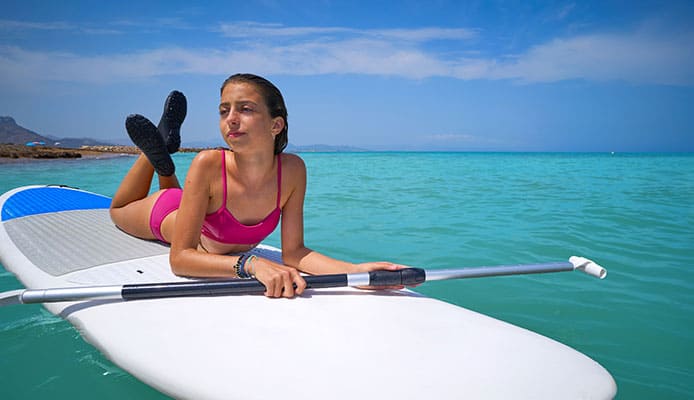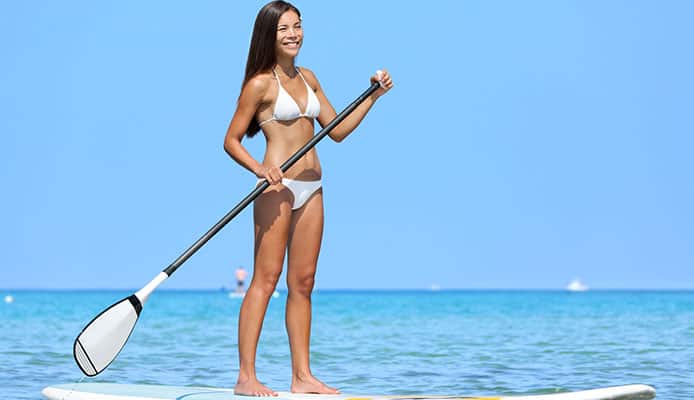
The major reason why standup paddleboarding, or simply SUP, is growing in popularity is that it is a great full-body workout. Like any benefits of paddleboarding cannot be underestimated. You get to lose some weight, tone your muscles, and improve your overall body health.
People of all fitness levels, paddling skills, and age can try paddleboarding. And unlike surfing where you need the waves to ride your board, the sport can be done on any water, be it a river, lake, or ocean. The very still, flat water will be the best for those who are still learning how to stand up paddleboard.
This post addresses some of the common questions in standup paddling discussion including “What is SUP?”, “How to get started with SUP?” and the like. So guys (and girls) grab your pens and notebooks and let’s get to the deets, shall we?
Exactly What Is Stand Up Paddleboarding?
SUP is basically a combination of surfing and boating. As the name hints, you stand on a paddleboard and use a paddle to push yourself forward. A stand-up paddleboard is longer, wider, and got more buoyancy than a typical surfboard, which helps you to balance comfortably on it.
SUP uses a longer paddle than canoeing and kayaking. Experts recommend that a SUP paddle be between four and seven inches taller than the paddler. This is to ensure that the paddleboarder doesn’t have to bend when slicing the water.
But what is paddle boarding health benefit if you will be standing up the entire time, moving only your arm muscles? You may wonder!
Well, paddleboarding is more complex than it appears. On the surface, it may seem like just slicing the water but tell you what, there is so much happening to your core muscles and entire body. It’s true, more SUPs appear more like a flat board and so many people think that they are only standing on the board and working out their arms.
Okay, we don’t dispute that your arms get most of the workout, but studies have shown that this fun watersport benefits the rest of your body as well. This is especially true in paddleboarding where riders paddle either standing up or sitting down on a chair, a.k.a. SUP kayak hybrids.
Yup! SUP manufacturers are now incorporating kayak features into the boards to give them a more curved (boat-ish) look. SUP kayak hybrids get paddlers reaping the benefits of paddleboarding and kayaking.
Like in kayaking, sitting down and turning the upper part of your body from side to side charges the lower back and abdominal muscles giving you an amazing abs workout. Of course, it won’t be as intense as full crunches or sit-ups but you will definitely feel and see the changes over time. If you are on a budget and looking to have a taste of both worlds from single equipment, then a SUP-Yak could be a great craft to invest in.
How To Get Started With Stand Up Paddle Boarding
Standup paddleboarding is slowly beginning to rule the world of water sports because first of all, it is not discouragingly difficult. You only need a few hours to learn how to fall off and get back on your SUP. Sure, learning how to stand on the board, the most sensitive part of SUPing, maybe a little overwhelming for beginners, but this too should not involve too much dunking.
A three to four-hour session with a professional instructor will give you the confidence you need to get started with paddling. And once you have gotten the hang of standing up and maneuvering your craft, you will hit that ride like nothing.
Preparing For Standup Paddle Boarding
A breathtaking SUP will only be possible if you prepare adequately, and the first thing you need to do is to purchase the right standup paddleboarding gear and equipment. Though a board and paddle will get you moving on the water just fine, there are a few more items you will need to invest in to make your adventures safe and more comfortable especially if you are just learning how to paddle a stand-up paddleboard. These include a life jacket or PFD, an extra paddle, a pair of water shoes, and a safety kit.
Familiarize yourself with all the parts of your standup paddleboard and their functions. Learn how to operate the rest of the gear before heading out. For instance, if you will be using a PFD, practice how to activate the manual inflation. And most importantly, learn how to signal for help, just in case you find yourself in an emergency.
It would also help to paddle in the calm, flat waters in the first few days after your training. Plan your adventures on sunny days or when there is little wind. Once you have completely mastered the ropes, you can graduate to more challenging conditions.
If you will be riding a SUP-yak hybrid, you may want to learn the various types of kayak strokes to prime yourself for when you will be paddling while sitting down. Also, have many how to get back into a kayak after it’s flipped over, get your Eskimo roll right, and have kayak edging and bracing strokes at your fingertips.
Don’t forget to tell someone where you are going too, including how many people you will be going with and what time you expect to come back. That way, if you don’t show up at the specified time, the person will have enough info to present to the authorities.
Transporting Your Paddle Board
Apart from “what is SUP?”, another question that we get quite often from first-time paddlers is “How do I carry my paddleboard to my destination?”
We agree paddleboards are large, and getting them to your paddling spot can be a tough task. So here are some pointers to make this less stressful:
Use your shoulder: Hold your paddle with one hand. Then, with the nose of the paddleboard on the ground, lift the board and move to its center. Shift its weight back so you can balance it on your head. Next, shift the paddleboard over to your shoulder and try to balance it. Reverse the steps to lay the board down.
Use your hand: At the center of your paddleboard, there is a small carry handle that you could use to transport your board to and from your paddling area. Just grab the handle, lift your board, and go. Easy peasy!
Strap it on your car: You can strap your paddleboard on your car and carry it to wherever you want, and depending on the size of your board, even a surfboard rack could help with this. If your vehicle has a rack, however, just tie down your board to the existing rack.
Put it in a bag: This is especially for air or long-distance travel. Some manufacturers design SUP board bags to make carrying your board easier. Most of these are well padded but it is always nice to add extra padding especially if you will be walking with the bag for a long distance. For airplane travel, make sure to find out the board charges before booking your ticket.
You might also be interested in: Plastic VS Fiberglass Paddleboard one Should you buy?
How To Care For Your Paddleboard
You just purchased this butt-kicking paddleboard, now what? How do you maintain it in good shape to extend its life? This might help:
- Always keep your SUP out of the sun especially if it is an inflatable paddleboard. The best place to store it would be a dry shaded area.
- Make sure to dry your board completely before storage to prevent mold and mildew buildup.
- Carry your board in a bag to prevent scratches and damage.
- Be careful when laying your board down or putting it in the water. In particular, be on the lookout for sharp objects or rocks.
- Wash your paddleboard thoroughly after a saltwater trip.
- Inspect board and paddle regularly for cracks or dings and fix them whenever possible. If you find a scratch that could escalate into a leak, repair it right away.
Globo Surf Overview
SUP is a fun activity that can be done on any water body. It allows you to experience the amazing outdoors and provides you with a perfect workout for your body.
If you are not a water sports enthusiast, you may be wondering what is paddle boarding. Luckily, we have broken this down for you, including how to get started and stay safe on the water, in case this is the first sport you want to get acquainted with as you embark on your journey to the water sporting world. Just make sure to invest in the right gear and take good care of it so it can serve you the longest.
Paddling paddle Board Guides:
- Winter Paddling Guide: How To Paddle Board In Cold Weather?
- Fiberglass SUP VS Inflatable SUP Comparison Guide
- Paddle Board Safety Guide: 10 Things You Should Never Do
- 10 Reasons Why You Should Try Paddle Boarding
- All The Parts Of A Standup Paddle Board
Paddling Paddle boards Reviews:
- Places To SUP In Colorado
- Place To SUP In Australia
- Places To SUP in California
- Types of Paddle Sports
- Romantic Things To Do on a Paddle Board


